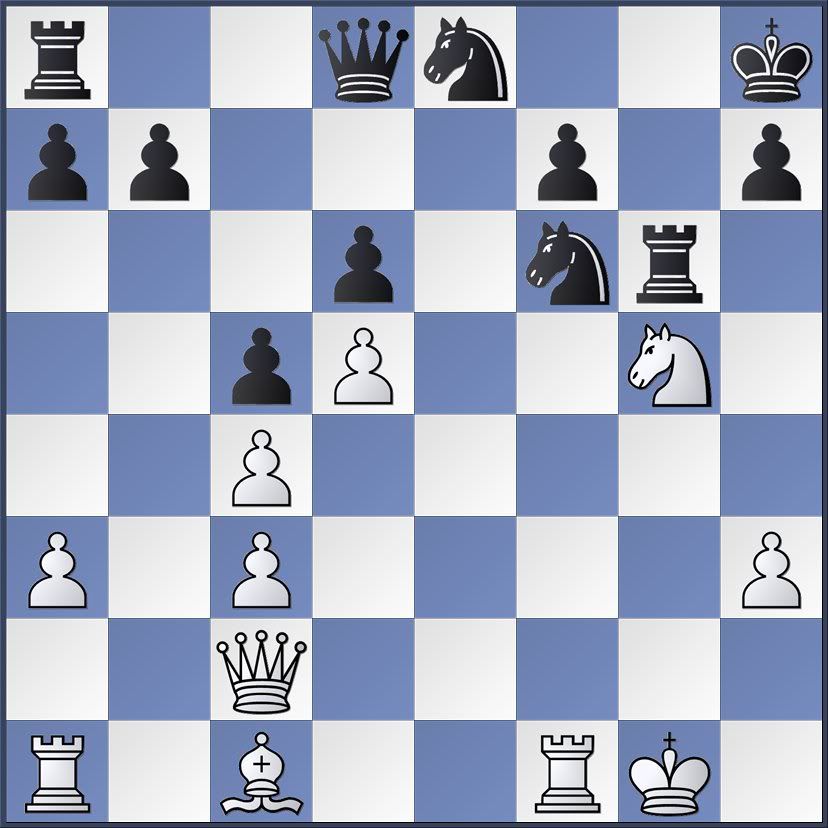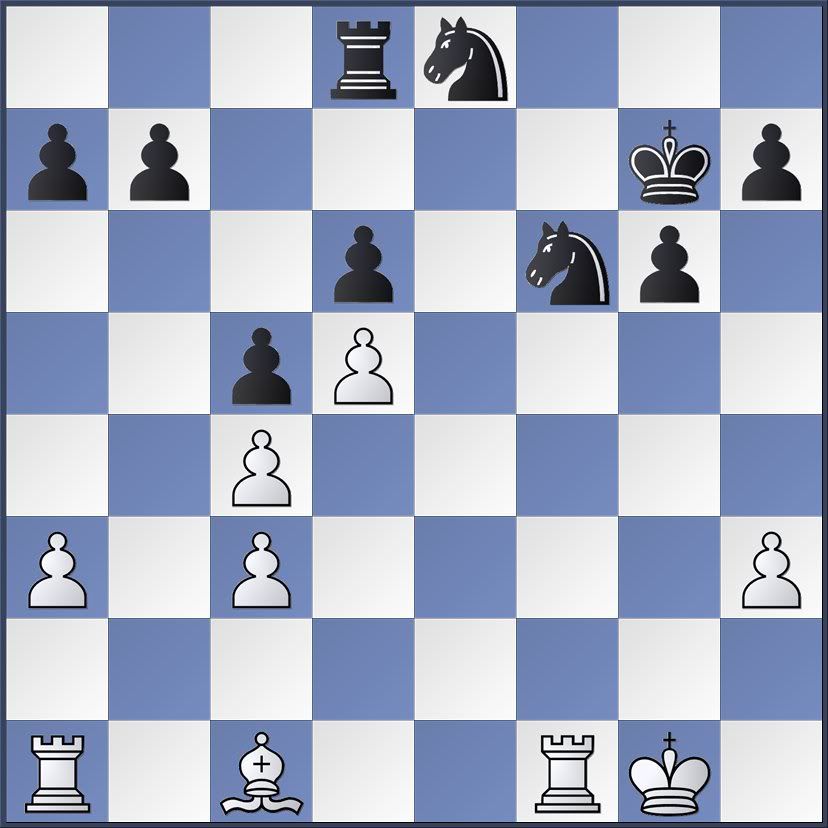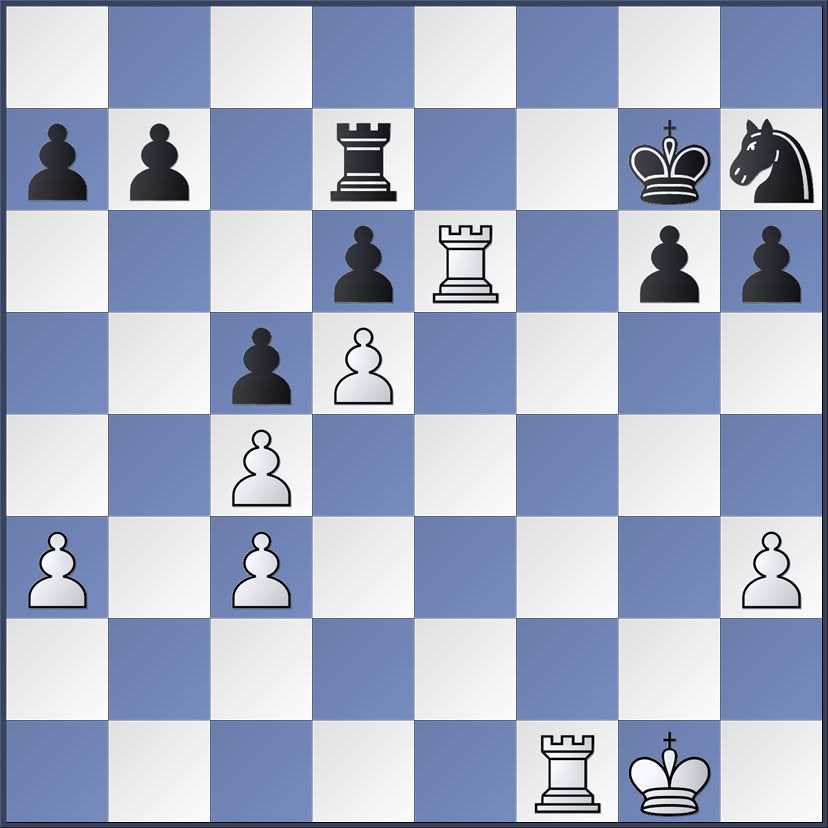The Software
Once I've opened a random position in CB 8, one click closes the database software and opens Hiarcs 10 or Fritz 9--the two engines share the same interface. Then I can play against the engine. I have Hiarcs 12, but it lacks compatibilty with ChessBase 8. Hiarcs 12, Fritz 11, and other recent engines work well with ChessBase 10, but older engines cooperate with older database software. I could buy the latest version (CB 10), but that requires a new computer, and I'd like Microsoft to get more of the bugs out of Vista before taking that plunge.
Today's Exercises
When I opened my Reinfeld Sacrifices and Combinations database this morning, it opened to WCASC #142, which I managed to solve in less than five minutes. Hiarcs used ten minutes (I set the game at G/15) to choose its first move, and resigned after my fifth move. As this one took little time, I went ahead with WCASC #143.
White to move

1.Qxg6 fxg6 2.Nf7+ Kg7 3.Nxd8 Rxd8 and that's where Reinfeld's solution ends, but the work begins. White is ahead an exchange, but Black has an extra pawn for the exchange. The doubled c-pawns could become a vulnerable weakness if Black's knights move forward to better posts.
A Winning Advantage?
One of my college roommates was fond of the expression "where the rubber meets the road" when talk must give way to action. Such is the case here. Reinfeld states that White wins with the advantage of the exchange. Finding such wins is my focus in this engine training.
White to move

The rooks must coordinate their efforts and White must find some work for the bishop.
a) 4.Rb1
b) 4.Ra2
c) 4.Re1
d) 4.Bg5
I looked at 4.Rb1, but after 4...b6, have I made progress? I didn't think so. I then considered 4.Ra2 and 4.Bg5. I failed to examine 4.Re1.
After the game, I loaded the game in Hiarcs 12 and turned on infinite analysis. The engine's top two choices were 4.Rb1 and 4.Re1, but when I executed 4.Ra2, its evaluation went up dramatically. Then, backing up to the diagram position Hiarcs favors this move by a substantial margin and 4.Bg5 becomes its second choice. It is gratifying to learn that the engine favors the move I tried first.
My first effort went thus:
4.Ra2 Ne4 5.Re2 N8f6 6.Rfe1 Re8 7.Kg2, but I couldn't find something useful for the bishop. After many moves, my position became worse and Black gained a slight advantage. I backed the game up and tried again.
My second effort went thus:
4.Bg5 h6 5.Bxf6 Nxf6 6.Rae1 Rd7 7.Re6 Nh7
White to move

I tried 8.h4 Nf8 9.Re8 Nh7 10.Rfe1 Kf7 and Hiarcs 12 likes all my moves, as well as those of its older version.
White still has a theoretically decisive advantage, but the best I was able to achieve was a draw. I suspect that a few daft moves might put Black in zugzwang, but could not find these moves.
I tried 11.Rh8, but after 11...Nf7 could not find a way to improve. Hiarcs 12 prefers 11.R1e6, but I didn't examine this move while playing. I could start again from there, but that must wait for another day.














chesslab.com recommends:
ReplyDelete11. R8e6 h5 12. Kf2 Nf6 13. Rf1 Ng4+ 14. Ke2+ Kg7 15. a4 Ne5 16. Rff6 Re7 17. Rxd6 Nxc4+ 18. Rfe6 Rxe6+ 19. Rxe6 Kf7 20. Re4 Nd6 21. Rf4+ Ke7 14. Kd3 with +2.01 evaluation.
Nice practise. I hope you learn from it, especially board view. One tip, dont feel bad when you cant win the game after it. It's the practise you get that is important.
ReplyDelete